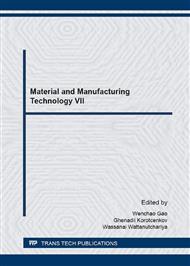[1]
J. Thangtong and S. Prombanpong: An Analysis of Burn Defect in Hard Anodized Process of AL 3003, Advanced Materials Research Vol. 1119 (2014), pp.475-479.
DOI: 10.4028/www.scientific.net/amr.1119.475
Google Scholar
[2]
J. L. Trompette, L. Arurault, S. Fontorbes and L. Massot: Influence of the Anion Specificity on the Electrochemical Corrosion of Anodized Aluminum Substrates, Electrochemical Acta, Vol. 55 (2010), pp.2901-2910.
DOI: 10.1016/j.electacta.2009.12.063
Google Scholar
[3]
C.K. Chung, M.W. Liao, H.C. Chang and C.T. Lee: Effects of Temperature and Voltage Mode on Nanoporous Anodic Aluminum Oxide Files by one Step Anodization, Thin Solid Films, Vol. 520 (2011), pp.1554-1558.
DOI: 10.1016/j.tsf.2011.08.053
Google Scholar
[4]
X.Y. Han and W.Z. Shen: Improved Two-Step Anodization Technique for Ordered Porous Anodic Aluminum Membranes, Journal of Electroanalytical Chemistry, Vol. 655 (2011), p.56–64.
DOI: 10.1016/j.jelechem.2011.02.008
Google Scholar
[5]
T. Aerts, I.D. Graeve and H. Teryrn: Study of Initiation and Development of Local Burning Phenomena During Anodizing of Aluminum under Controlled Convection, Electrochemical Acta, Vol. 54 (2008), pp.270-279.
DOI: 10.1016/j.electacta.2008.08.004
Google Scholar
[6]
Y.K. Junghoon Lee, H. Jang and W. Chung: Cr2O3 Sealing of Anodized Aluminum Alloy by Heat Treatment, Surface & Coatings Technology, Vol. 243 (2014), pp.34-38.
DOI: 10.1016/j.surfcoat.2012.05.071
Google Scholar
[7]
I. Tsangaraki-Kaplanoglou, S. Theohari: Effect of alloy type on the anodizing process of aluminum, Surface & Coating Technology, Vol. 200 (2006), pp.2634-2641.
DOI: 10.1016/j.surfcoat.2005.07.065
Google Scholar
[8]
Yann Goueffon, Laurent Arurault: Black anodic coatings for space applications: Study of the process parameters, characteristics and mechanical properties, Journal of Materials Processing Technology, Vol. 209 (2009), pp.5145-5151.
DOI: 10.1016/j.jmatprotec.2009.02.013
Google Scholar
[9]
Jihun Oh, Carl V. Thompson: The role of electric field in pore formation during aluminum anodization, Electrochimica Acta, Vol. 56 (2011), p.4044–4051.
DOI: 10.1016/j.electacta.2011.02.002
Google Scholar
[10]
J. J. Roa, B. Gaston-Garci, E. Garcia-Lecina and C. Muller: Mechanical Properties at Nanometric Scale of Alumina Layers Formed in Sulfuric Acid Anodizing under Burning Conditions, Ceramics International, Vol. 38 (2012), p.1627–1633.
DOI: 10.1016/j.ceramint.2011.09.053
Google Scholar


